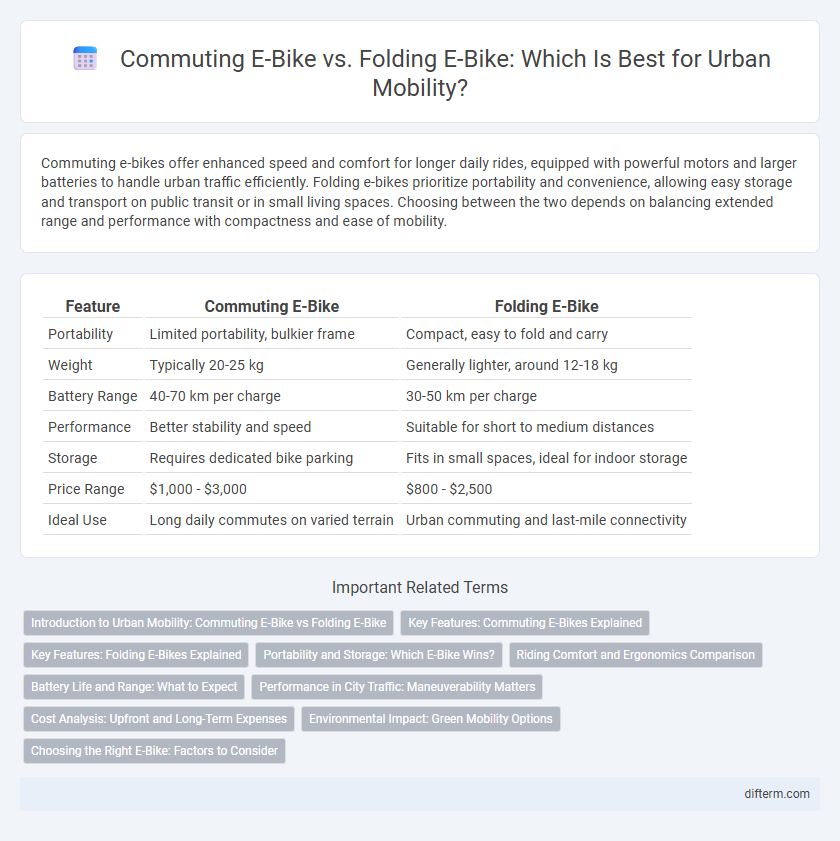Commuting e-bikes offer enhanced speed and comfort for longer daily rides, equipped with powerful motors and larger batteries to handle urban traffic efficiently. Folding e-bikes prioritize portability and convenience, allowing easy storage and transport on public transit or in small living spaces. Choosing between the two depends on balancing extended range and performance with compactness and ease of mobility.
Table of Comparison
| Feature | Commuting E-Bike | Folding E-Bike |
|---|---|---|
| Portability | Limited portability, bulkier frame | Compact, easy to fold and carry |
| Weight | Typically 20-25 kg | Generally lighter, around 12-18 kg |
| Battery Range | 40-70 km per charge | 30-50 km per charge |
| Performance | Better stability and speed | Suitable for short to medium distances |
| Storage | Requires dedicated bike parking | Fits in small spaces, ideal for indoor storage |
| Price Range | $1,000 - $3,000 | $800 - $2,500 |
| Ideal Use | Long daily commutes on varied terrain | Urban commuting and last-mile connectivity |
Introduction to Urban Mobility: Commuting E-Bike vs Folding E-Bike
Commuting e-bikes offer extended battery life and greater range, ideal for daily travel across urban landscapes, whereas folding e-bikes prioritize compactness and portability for seamless integration with public transit. Both models optimize urban mobility by reducing reliance on cars and cutting emissions, yet folding e-bikes cater specifically to last-mile connectivity and limited storage spaces. Understanding the trade-offs between sustained ride comfort and versatile storage solutions is key for selecting the most efficient e-bike for city commuting.
Key Features: Commuting E-Bikes Explained
Commuting e-bikes feature robust frames, extended battery life, and ergonomic designs optimized for daily urban travel, offering enhanced comfort and stability during longer rides. Folding e-bikes prioritize compactness, lightweight construction, and quick fold mechanisms, ideal for mixed-mode commuting including public transport integration. Both types provide pedal-assist motors and customizable power settings, but commuting e-bikes generally support higher speeds and greater range suited for consistent daily mileage.
Key Features: Folding E-Bikes Explained
Folding e-bikes combine electric mobility with compact design, offering easy portability and convenient storage ideal for urban commuting and multi-modal travel. Key features include a lightweight frame, quick-folding mechanisms, and integrated battery systems that maintain strong power output despite their smaller size. These e-bikes enhance flexibility by fitting into tight spaces such as Public Transit racks or office closets, making them a practical choice for city riders seeking efficient, eco-friendly transportation solutions.
Portability and Storage: Which E-Bike Wins?
Folding e-bikes excel in portability and storage, featuring compact designs that easily fit into car trunks, public transport, or small apartments, making them ideal for urban commuters with limited space. Commuting e-bikes often prioritize ride comfort and battery capacity but have larger frames that are less convenient to store or carry indoors. For users needing versatile transport solutions that balance electric assistance with easy storage, folding e-bikes offer a distinct advantage in portability without sacrificing essential performance.
Riding Comfort and Ergonomics Comparison
Commuting e-bikes typically offer larger frames and wider tires, enhancing stability and shock absorption for a smoother ride over long distances and urban potholes. Folding e-bikes prioritize compactness, resulting in smaller wheels and a more upright riding position that reduces rider fatigue but may sacrifice some suspension comfort. Ergonomically, commuting e-bikes provide adjustable handlebars and seats to optimize posture, while folding e-bikes often have fixed geometry to maintain foldability, influencing overall rider comfort during extended use.
Battery Life and Range: What to Expect
Commuting e-bikes typically offer larger battery capacities, enabling ranges between 40 to 70 miles per charge, suitable for longer daily trips. Folding e-bikes prioritize compactness, often featuring smaller batteries that provide ranges from 15 to 40 miles, ideal for short urban commutes and multi-modal transportation. Battery life varies based on motor efficiency and riding conditions, with commuting e-bikes generally delivering longer endurance for extended use.
Performance in City Traffic: Maneuverability Matters
Commuting e-bikes deliver robust performance with powerful motors and larger wheels, ensuring stability and speed on urban roads, while folding e-bikes prioritize compact design and enhanced maneuverability for tight city spaces. Maneuverability in city traffic is crucial, with folding e-bikes allowing swift navigation through crowded sidewalks and easy storage on public transit. The trade-off between power and portability defines the choice, where commuting e-bikes excel in speed and endurance, and folding e-bikes offer convenience and flexibility for dynamic urban environments.
Cost Analysis: Upfront and Long-Term Expenses
Commuting e-bikes typically have higher upfront costs, ranging from $1,000 to $3,000, due to their robust build and larger battery capacity, while folding e-bikes generally cost between $800 and $2,500, offering compact convenience at a lower entry price. Long-term expenses for commuting e-bikes include battery replacements every 3-5 years costing $200 to $600, with maintenance focusing on drivetrain and suspension components, whereas folding e-bikes usually incur lower maintenance costs but may require more frequent battery charges and occasional hinge or folding mechanism repairs. Insurance and accessory costs such as locks and lights are comparable for both types, but the ability to store folding e-bikes indoors can potentially reduce theft-related expenses over time.
Environmental Impact: Green Mobility Options
Commuting e-bikes generally offer a lower environmental impact due to their larger batteries and longer range, reducing reliance on fossil fuel-powered transport for extended trips. Folding e-bikes provide green mobility benefits through their compact design, enabling seamless integration with public transit and promoting reduced car usage in urban areas. Both options contribute to sustainable commuting by minimizing carbon emissions and supporting eco-friendly transportation infrastructure.
Choosing the Right E-Bike: Factors to Consider
When choosing between a commuting e-bike and a folding e-bike, consider factors such as portability, battery range, and riding terrain. Commuting e-bikes typically offer longer battery life and enhanced comfort for daily rides, while folding e-bikes provide compact storage and ease of transport on public transit. Evaluate your daily route, storage space, and frequency of multimodal travel to determine the best e-bike fit for your mobility needs.
commuting e-bike vs folding e-bike Infographic

 difterm.com
difterm.com